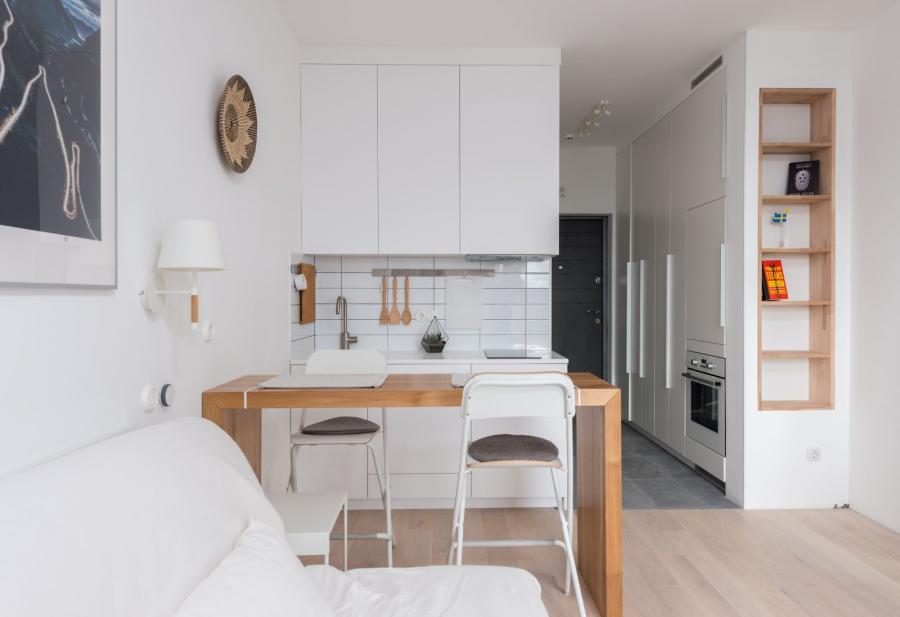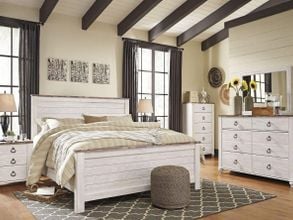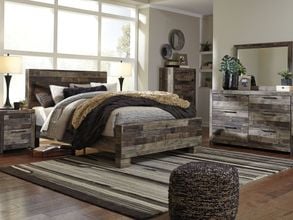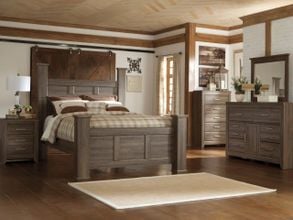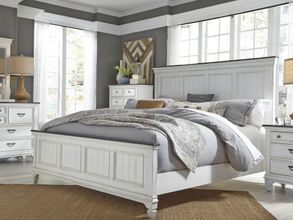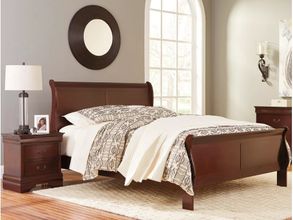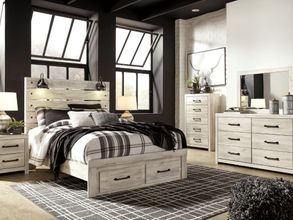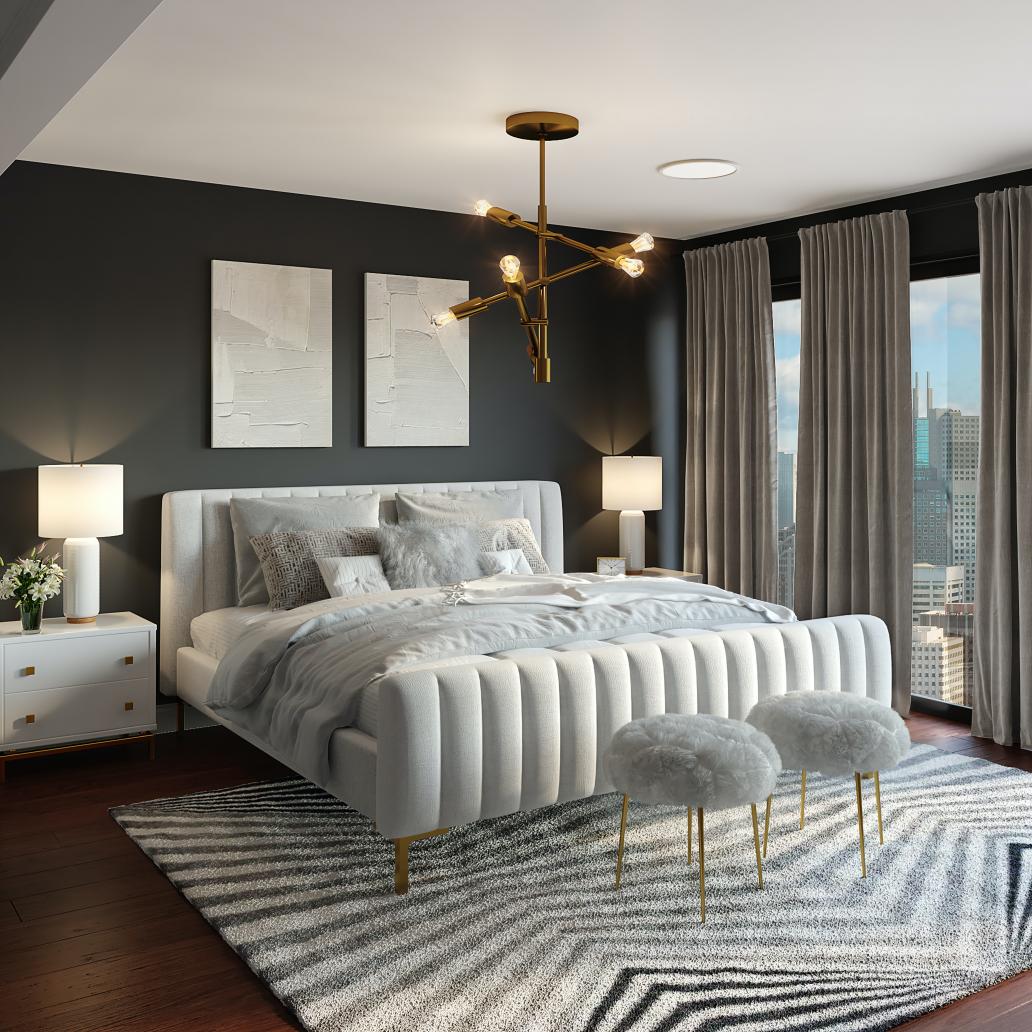
Sleep. It is not only something we all do but something we all need. We spend our entire lives constantly on the go, so at the end of those busy days, a good night’s rest is always on our minds. We need this so that we can wake feeling refreshed the next day and be the best version of ourselves.
One of the best things we can do to ensure a good night’s rest is to create an environment that will help promote better sleep. From design tips on selecting the perfect mattress to healthy sleeping habits, here we explore some tips to create a perfect bedroom so you can sleep well at night.
Bedroom Design Tips for Better Sleep
Where to start? Decorating your bedroom can leave you feeling overwhelmed with all of the options to choose from. Here are 10 tips to get you started to create a space that will help make this process simple and focused on that good night’s sleep. These key elements to your perfect bedroom design might even spark some inspiration.
Tip 1: Create a Serene Space
Think about a place that makes you happy. Go ahead, close your eyes, and daydream for just a moment. Maybe it’s the calming waves on a beach while you sit with your toes in the sand. Or, maybe it’s the fresh breeze on your skin while you listen to the trees blow in the wind in the woods. Everyone’s sense of calm looks and feels a little different. Think about what that is for you and then begin to create your space a serene escape that mirrors that image.
Tip 2: Bring in Feng Shui
An unbalanced bedroom can affect your life in different ways, such as your health, relationships, and finances. Use your decor and furniture to create a positive flow of energy and balance. When thinking about bringing this energy and balance into your bedroom, keep these 5 elements in mind: wood, fire, earth, water, and metal.
Tip 3: Choose Calming Colors
Cool colors such as light blues, grays, greens, and lavenders, in addition to neutral shades are ideal for the bedroom. This is because cool colors help promote a sense of calm. A survey of 2,000 people found that those who had blue bedrooms averaged 7 hours and 52 minutes of sleep each night. Another survey found that purple bedroom walls were the least conducive to a good night’s sleep. Whatever color you choose, remember that a bedroom’s color scheme will set the mood, and affect your emotions and your routines.
Tip 4: Clean Out The Clutter
Clutter and organization hand in handplay a role in your bedroom. While it is easy to use the free space underneath a bed as ‘out of sight, out of mind’ storage. Try to think about how you can ensure you are not just aimlessly using this area to store items. Instead, if you need to use this space for storage, how can you do it in a little more mindful way. This also includes removing things that remind you of daily stressors and to-do lists, such as your work: leave the laptop in another room, place your work clothes in a hamper, and simply remove any other reminders of your day-to-day.
Tip 5: Turn Off The Lights and Disconnect
For a good night’s sleep, we need our brains to turn off. To do that, creating a cool, dark environment is essential. If you have electronics in your bedroom, try to hide them. If you have a TV, ensure that you keep it off while you are falling asleep – maybe even store it in an enclosed space. Keep things such as cell phones in a drawer and out of reach. Another way to help calm the brain down before bedtime is to dim the lights gradually and even install blackout shades – all things that will help your body release the melatonin it needs for a good night’s sleep.
Tip 6: Keep It Cool And Quiet
A cool and quiet environment will not only help you find that sense of relaxation your body needs to make that shift at the end of the day, but it will also help you keep yourself in a state of rest. Simple things such as sleeping with the door closed, placing rugs where you walk, and using a fan to keep the temperature controlled will create this sense of cool and quiet you need to get those zzzs.
Tip 7: Choose Proper Bedding
Seriously, if you do nothing else, this is the one thing to pay attention to. Think about the last time you invested in a new mattress. If you can not remember, it is probably time to invest in a new one. It is recommended to replace your mattress every 7 to 10 years, but it’s also important to listen to your body. If you wake up sore or feeling not rested, that’s your sign.
Tip 8: Add A Relaxing Scent
Some of our favorites are chamomile, lavender, ylang-ylang, and cedar. Whether you use a candle, wax burner, or a diffuser, these scents are calming and can help reduce stress and anxiety that often keeps us activated at the end of a day and make that shift into rest mode.
Tip 9: Make Your Bed Every Morning
Yes, every morning! While this might feel like a chore, try to shift your mindset with this. Think about how nice it feels to crawl into a made bed at the end of the day. This simple task at the beginning of your day is setting your end of the day up for success to help you with the unwinding process.
Tip 10: Try a Mindful Meditation Before Bed
Meditation is a relaxation technique that can help you sleep better by tapping into inner peace. It can help you fall asleep twice as quickly and help you stay in that deep state of rest, helping you wake feeling refreshed. A simple way to incorporate meditation into your nightly routine is to first prop the body up with blankets and pillows, close the eyes, and focus on the breath. You can repeat to yourself “I am breathing in” and “I am breathing out”. After a few slow inhales and exhales, you will feel a sense of calm overcome your body.
Bed Frames For Perfect Sleep
A mattress without a frame is like a table with no legs. Although the top of the table is what we use day in and day out to eat off of, the part that supports the meals we cook and so much more, without it we would be eating off of the ground. The foundation of the table, its legs, are an important part of the table functioning the way that we need it to.
The same concept applies to our bed frame. There are lots of different styles to choose from. Here we will look at the different types of bed frames and how to choose one that will help you optimize your sleep. We will explore bed sizes, types of bases, and the materials that you have to choose from.
Bed Sizes
Before you decide what type of bed you want, you will first want to determine what size you are looking for. The bed size will depend on lots of things such as how much space you have in your bedroom, how many people will be sleeping in the bed, and also how tall the people in the bed are. Here is a size guide to help you determine what to choose. Before you begin, measure the space where the bed will be going to make sure it will fit.
|
Type |
Size |
Good For |
|---|---|---|
|
38” by 75” |
Sing sleepers Kids Bunk beds |
|
|
Twin XL |
38” by 80” |
Taller teens Dorm rooms Single sleepers |
|
53” by 75” |
Single sleepers Young adults Recent grads Guest rooms |
|
|
60” by 80” |
Single sleepers Couples Rooms 10’ by 10’ |
|
|
76” by 80” |
Single sleepers Couples Families with kids or dogs |
|
|
72” by 84” |
Couples Sleepers 6’ or taller |
Bed Bases and Materials
So how do you choose a bed frame exactly? Certainly one of the first things you want to consider is budget. A frame can cost anywhere between $100 and $2000. It is often easy to go directly for the most cost-effective option because we often spend most of our budget on the mattress itself but remember that the foundation is just as important as the mattress itself. After all, our sleep is an important part of our well-being so be sure to go with the option that fits within your budget.
After determining what size of mattress you are going with, next, you’ll want to determine the size and type of bed base to select. The types of bed bases to choose from will depend on your own personal needs, the aesthetics and design of your bedroom, and your lifestyle including:
Platform Bed
This style of bed frame is fairly modern but also simple in its design. The most considerable benefit to this bed frame is that you do not need a box spring. You can place your mattress directly on top of the frame. It is a sleek design, and it may or may not include a headboard.
Metal
A metal bed frame is popular due to its durability and you can find them in a variety of styles – from intricate to simple. They can also hold a heavier mattress effortlessly.
Adjustable
These frames are plugged into the wall and controlled by a remote. They allow you to adjust different parts of the bed, including the head and legs. These are great options for those who need to elevate their head or feet or who suffer from mobility issues.
Four Poster or Canopy
These types of bed frames have a post coming up from the ground on each corner of the bed. These work very well in larger bedrooms because they take up a lot of space. Canopy beds are similar in the sense that they have four posts and all connect at the top. With this option you can even drape fabric from the top to give it a whimsical look and feel.
Bunk Beds
Not only are these space-saving types of beds for the kiddos, they bring in the sense of fun. These are simply two beds that stack above one another and, typically, the top bed is accessed using a ladder.
Upholstered
This style of bed frame brings a cozy look and feel into the room. The frame is wrapped in fabric, giving it a warm feeling all around. It ranges from velvet, fabric, leather, suede, etc. This style can bring a simple or even fancier vibe with studs or embellishments.
Storage
Built-in storage can often be exactly what we need. Being able to store things, and leverage every inch of extra space you have can be an important element when you live in a smaller home. Beds that offer built-in storage can lend a hand in this. The built-in storage in beds can range from drawers, cabinets or even shelves. They do often take up more space but can create invaluable storage for things such as clothes, books, and other personal belongings.
Wood
While there are many different types of wood bed frames, they often have one thing in common: they have a soft and more traditional look to them. But probably the most significant benefit to this bed frame is they are durable and sturdy. Wood bed frames come in so many different styles you can often match your decor scheme quite easily.
The moral of the story with picking a bed frame is to remember that it is a support system to hold your mattress. It lifts your mattress up off of the ground, making it easier for you to access. While aesthetics, ease of use, and moving along with budget should play a big role in your decision, it is also important to remember the right bed frame should support you when you sleep. You do not want your mattress to begin to sag or ultimately be unable to support you. This is what can result in restless nights. Ensuring you are selecting the bed frame that best supports your mattress and aligns with your sense of style will help you in creating the right support and environment for a good night’s sleep.
And here is a quick reference guide to the pros and cons of the various types of bed frames you can choose from:
|
Bed Base Type |
Pros |
Cons |
|---|---|---|
|
Platform |
No box spring required Minimalistic design |
May feel low to the ground |
|
Metal |
Sturdy Easy to clean |
Can be heavy |
|
Adjustable |
Head and feet can adjust for comfort |
Expensive |
|
Four Poster or Canopy |
Makes a statement Traditional look |
Large and hard to move Requires tall ceilings |
|
Bunk Beds |
Saves space Fun for kids, guests and sleepovers |
Large and hard to move Have to climb to get into |
|
Upholstered |
Comfortable and soft Different types of fabric to choose from |
Requires vacuuming Not as durable |
|
Storage |
Extra storage |
Bulky and hard to move Can be costly |
|
Wood |
Wide range of styles Easy to match your decor |
Heavy and hard to move |
How To Choose A Mattress
Choosing a new mattress can be overwhelming, to say the least. You want one that is comfortable, yet supportive to give you the best sleep. And, you want it to be durable so that you don't have to replace it within a few years. Because mattresses can be pricey, you want to make sure what you are investing in is actually worth the cost. To help you get a handle on how to choose, here is a guide to equip you with the knowledge you need to find the best mattress, right firmness, and features to meet your needs.
Mattress Types
First, let’s take a look at your options for the different types of mattresses you have to choose from. There are several different types of mattresses to take a look at. Although your spring mattress is the most common and well-known type of mattress, these other types have gained notability in recent years. Let us take a look at the basics of each to help you decide which one might be right for you.
|
Mattress Type |
Material |
Good For |
|---|---|---|
|
Open Spring |
Coils |
Cost conscious consumer Guest rooms |
|
Pocket Spring |
Springs |
Those that get warm at night Couples |
|
Memory Foam |
Foam |
Those with allergies Couples |
|
Latex |
Latex Foam |
Those with allergies and asthma Those that get warm at night |
|
Hybrid |
Spring Core Foam or Latex |
Those looking for comfort and support |
|
Airbed |
Air |
Those looking for flexibility in support Couples |
|
Bed in a Box |
Memory Foam |
Those with no time to mattress shop |
Open Spring
You might also know these as an open coil or continuous coil mattresses. They contain one long coil that is formed into numerous springs. These types of mattresses get their shape from an additional, more broad wire that maintains their shape. This is a good value and is a very lightweight option. One thing to pay attention to is that these types of mattresses tend to be the least supportive option. These mattresses are good in guest rooms where they will not be used as often.
Pocket Spring
This is a more luxurious style of a spring mattress because it contains numerous single springs that are retained inside individual pockets. Each spring has its own support making this a more supportive option than an open spring style of mattress. You can also select different levels of firmness with this type of mattress. One benefit of this style of mattress is that they are breathable. This is a great option for those that tend to get warm at night. One thing to consider with these mattresses is that they tend to be heavier and may contain materials many are allergic to, such as lambswool. Because of the individual springs, it is a good option for couples as the movement does not travel as easily as an open spring mattress.
Memory Foam
These mattresses are made solely of foam and do not have coils of any sort. They are known for contouring and supporting the body, unlike other mattresses. They also isolate motion making it a good option for couples. This is also the type of mattress that is most popular next to your traditional innerspring type of mattress and has a more modern approach to a mattress. The foam is a moldable material that often adjusts easily to the temperature and the weight of the bodies on the mattress. They are also a hypoallergenic option.
Latex
This is what you want for a top-notch bounce within a mattress. They are made entirely of latex and are some of the most durable and breathable mattresses on the market. Because of the opportunity to be made 100 percent of organic material, they are an excellent option for eco-conscious shoppers. And, because of how breathable they are, they are a great option for those that tend to overheat at night. Because of the material it is made of, it is also a good choice for those suffering from allergies and, or asthma. Be careful with this type of mattress, and be sure you purchase a higher quality one. The cheaper ones will often lose their shape over time.
Hybrid
This type of mattress combines a couple of different types of materials. It typically contains innerspring at its core and is encompassed with another type of material such as foam or latex. You will find a blend of contouring support and bounce with these. They are the best of both worlds with the different types of mattresses. Simply put, these mattresses bring a balanced approach to features and your sleeping experience.
Airbed
The core of these mattresses is exactly what the name says – air. This type of mattress provides the most flexibility because with the touch of a button you can adjust how much, or little, support is provided. The pump adds or removes air as needed. These are also good options for couples because each side can be adjusted based on each individual's preference.
Bed in a Box
This is a relatively new concept of a mattress. It refers more to how the mattress is delivered and is a good option for those that do not have the time to go to a mattress store to ‘try before you buy’ and actually shop around for a mattress. You simply order this mattress online, and within days, it arrives in a box. The mattress is compressed inside the box, making navigating this on your own super simple. All you have to do is open the box, and the compressed mattress will begin to expand and find its natural mattress shape. This type of mattress can typically be ready for you to use within a few hours. They are made of a combination of different materials, often as a hybrid mattress.
The other thing that you will want to take into consideration is how firm of a mattress you want. This is a bit trickier, considering comfort is subjective and truly depends on each person's preference There is no real right or wrong with this.
If you’re not sure where to start, consider the position you sleep in and your weight. Take the time to think about what you want. While the most common is medium and medium-firm, it all comes back to your personal preference. This is something you will likely need to visit an in-person retail store and give some mattresses a try. When trying out mattresses, spend at least 10 to 15 minutes testing each mattress out.
To help you get started, here’s a simple guide to what you can expect when shopping for a specific comfort level:
|
Firmness Level |
Best For |
|---|---|
|
Extra Soft |
Sleepers under 130 pounds |
|
Soft |
Side sleepers under 130 pounds |
|
Medium Soft |
Sleepers under 130 pounds Side sleepers under 230 pounds |
|
Soft |
Back and side sleepers between 130 and 230 pounds |
|
Medium Firm |
Sleepers between 130 and 230 pounds Side sleepers over 230 pounds |
|
Firm |
Side sleepers over 230 pounds Back and stomach sleepers over 130 pounds |
|
Extra Firm |
Back and stomach sleepers over 230 pounds |
Sleeping Positions
The positions that we sleep in play a big role in the restfulness of our sleep. Have you thought about your position when falling asleep and then again when you wake up? If this is not something you have ever thought about before, make a note for the next few nights and mornings. As you are drifting off, simply notice. Notice where you are, the position of your body, what are you using to prop yourself up at night. And again when you wake up, what position are you in? Are the items you used to prop yourself up when you went to sleep in the same place? Are they in a different place? How is the way you woke up different from how you went to bed? Take the time to notice these things.
You might even keep a journal next to your bed for a week and take notes. Take notes on things such as your sleeping position when you get into bed and when you wake, but also take a few moments when you wake up in the morning to journal about how you slept, how you feel, what you notice about your sleep from the night before. Do you feel rested? Do you feel tight or sore? Do you feel refreshed? Do you feel ready to take on the day? Do you feel energized? Simply take a few minutes before you start your day to notice and journal about what you are noticing. After about a week, reflect on any patterns you noticed. Notice that falling asleep in one specific position over others resulted in a better night’s sleep, and waking feeling more refreshed. This might be something you ensure you are doing at night when crawling into bed. Additionally, these key insights can provide some direction on what type of mattress you need to ensure the right amount of comfort and support.
Back Sleepers
When you sleep on your back, you put more pressure on your lower back and strain on the psoas than in other sleeping positions. If the mattress is too soft and lacks the right amount of support, your torso will sink into the mattress too much. This ultimately puts your body into a u-like shape and can cause pressure and strain on the lower and upper body. On the contrary, if the mattress is too firm, there won’t be any forgiveness to allow for the natural curvature of the spine.
For those who tend to sleep on their back, you will want to select a mattress that provides moderate contouring of the entire body. The best type of mattress to choose is one that is medium-firm to firm.
Side Sleepers
Those that sleep on their sides will often experience extra strain and pressure where the body is the widest. Typically this is going to occur in the hips and shoulders. This is because we have sharp pressure points that are triggered when the body is out of alignment. If you think about a back sleeper, oftentimes, the body is in perfect alignment. This is because they are in the same shape as if they were standing straight up and down. When you lay on your side, your legs are closer together, causing strain on your hips, which can also radiate into the lower back. And, when you are on your side, your shoulders also roll together causing strain in the upper back and neck areas.
When a side sleeper is on a mattress that is too soft for them, the hips and shoulders drastically become out of alignment with the spine. When you sleep on a mattress that is too firm, you will feel pressure on these areas and it will ultimately cause the body to become out of alignment after remaining there for a long period of time. Without ensuring you have the right kind of mattress, side sleepers will often wake with pain throughout the body once they wake up in the morning. That said, side sleepers will fare best with a medium soft or medium-firm mattress.
Stomach Sleepers
Those who sleep on their stomachs will have a similar experience to those who sleep on their back except they will feel the strain and pressure the most on their lumbar spine. This is because they are putting that u-like shape into their body with the shoulders and hips elevated and the belly sinking into the mattress. The pressure that is placed on the lower back will take most of the strain.
Stomach sleepers will do best with a firm mattress. This type of mattress will help avoid the u-like shape that can occur from sleeping on the belly and will also help them avoid feeling as if they are suffocating by remaining face down throughout the night.
Combination Sleepers
Those that find themselves moving in various positions throughout the night are combination sleepers. You might find that you start on your back, but you might then move onto your side and then eventually onto your stomach. And of course, throughout the night, you might find that you are moving throughout these positions in different orders all night long.
If you are this type of sleeper, try to determine which position you tend to spend the most time in. This might take some intentional noticing where you are not only when you go to bed at night and when you wake up in the morning, but also if you wake up in the middle of the night, also notice what position you are in. After you determine what position you tend to sleep in most of the time, select the recommended mattress for that type of sleeper. If one position does not seem to prevail and you feel as though you spend an equal amount of time in these various positions, the best type of mattress will be a medium-firm mattress. Another thing to keep in mind and to take into consideration is picking a mattress that feels easy to move around in.
Body Types
One thing that can have as significant of an impact on your sleep, besides the position that you sleep in, is your body. We all have different bodies, so paying attention to this will have an impact on choosing the best mattress for your unique body to ensure you have the right support, comfort and desired features.
With lighter body types, those who tend to weigh less than 130 pounds, won’t sink as deep into a mattress. When we are sleeping, we want to ensure that our mattress contours our body – think about it as a hug, not too much, not too little, just enough to make us feel comfort and support. These people typically benefit more from a softer mattress. Specifically, an innerspring mattress tends to be the option that will provide the least amount of support, and a foam or hybrid mattress will provide the best support.
If you are in between body types, those that weigh between 130 pounds and 230 pounds, you can typically rely on the suggestion for a mattress based on your sleeping position alone. Foam, hybrid, and latex mattresses are all viable options for this type of body profile and you can typically pick based on your personal preference of features.
Those who weigh more than 230 pounds, will often sink a little deeper into a mattress. Specifically, you will notice sinking in around the parts of the body that are heavier than others. The concern with this is that spinal alignment is thrown off, and you risk pain in the hips, back and neck. To avoid this risk, these types of sleepers will want to lean towards selecting a mattress with more firmness. Additionally, with a more firm mattress, it will feel easier to move around in, and get in and out of, because you will not feel like you're sinking into it. Selecting a mattress that is made with thicker composite material and higher density will be the best option.
It is also important to note that a person’s weight is not the only factor to consider when looking at body types and selecting a mattress. Those with broader shoulders or broader hips might need to consider a mattress with more contouring to ensure those areas have the best support available. This is to avoid alignment issues that can cause pain in the body. Additionally, those over six feet tall need to ensure they are purchasing a mattress that will keep them completely supported from their head to their toes.
Best Pillows For A Luxurious Night’s Sleep
One of the single most important aspects of your sleep is your pillow. Yes–your pillow. In fact, the pillow you use to sleep on can make all the difference in the world for a good night’s sleep. A pillow is so much more than just something to rest your head on. It should provide you support and comfort, and when paired with the right mattress for your body, can often leave you waking from some of the best sleep.
Much like selecting a bed frame and a mattress, there are so many different options to choose from, so it can be overwhelming and even dizzying. And similar to selecting a mattress, there are many factors to consider such as if you are a side sleeper, back sleeper, or belly sleeper. There is a different type of pillow for each type of sleeper.
The truth is there really is no one single pillow that will be the best for each individual because our bodies are so different and unique. In addition to looking at what type of sleeper you are, think about what features are important to you. Are you a hot sleeper? Do you like a lot of support or prefer less support? When looking for a pillow, you will want to consider a few different things:
- Comfort – This is often a personal preference. Think about what features will help you feel like you can rest and relax.
- Support – This will be what level of support you need based on the type of sleeper you are.
- Temperature regulation – If you are often warm at night, aka a hot sleeper, considerwhat cooling features you will need.
Additionally, there are three different criteria to keep in mind:
- Pillow loft – This is the height of the pillow. If you are a side sleeper, you typically want a higher loft to ensure the gap between your neck and the pillow has ample support. For back and belly sleepers, a lower loft is typically sufficient to maintain the integrity of your alignment.
- Firmness – This will tell you how much, or little, support the pillow will provide. In other words, how much “give” will the pillow have when you rest your head on it. Side sleepers will want something on the firm side and belly and back sleepers can often get by with something less firm.
- Fill – Often, the loft and firmness you are aiming for will dictate what your pillow is filled with. However, if you have allergies or asthma, you will want to pay attention to what your pillow is filled with.
If you’re unsure, go with an adjustable pillow. These come with an extra filling that you can add or remove as needed that will help you adjust to find the right amount of comfort and support that you need. If you’re a hot sleeper, o get one that has some sort of temperature control built in. Because, after all, if you are too warm at night, this will impact your ability to feel comfortable and supported – the two most important things you need to get a good night’s rest. If you suffer from neck pain, you might want to consider a memory foam pillow. Lastly, try to choose one that has a machine washable cover, so you can keep your pillow fresh and change your pillows every two years.
Here are some suggestions on pillows for every lifestyle, budget and type of support and comfort you might be looking for:
Best Pillow Overall
The Coop Home Goods Original Adjustable Pillow is adjustable and the best value for the price point. It is the best option for anyone that wants an adjustable pillow but does not want to spend a lot. It is filled with non-toxic memory foam and comes with an extra half-pound of filling. It has a removable cover that can be washed. And, it is good for any type of sleeper. This mattress also comes in a queen or king size, depending on your preference.
Best Pillow for All Sleep Positions
The Casper Original Sleep Pillow will give you the plushness of a down-filled pillow but free from the allergens that an animal product-filled pillow can often come with. Instead of actual feathers, it is filled with an alternative fiber that gives you the same feel. This pillow is really good for those that move throughout various sleeping positions throughout the night. Both layers are machine washable making care for the pillow super easy. A benefit of this pillow is that it provides superior neck support while not compromising the filling throughout the rest of the pillow. It is also 100 percent breathable, making this a good choice for hot sleepers.
Best Pillow for Side Sleepers
The Purple Harmony Pillow is a top of the line pillow but does not come with the price tag of what a typical luxury pillow might have. It provides unmatched support for the head and the neck. It has an enhanced airflow technology built in and includes a moisture wicking cover making it a great choice for hot sleepers. And with this pillow they have three different sizes to choose from: low, medium and tall. With the perfect amount of support, this pillow is luxury without luxury pricing.
Best Pillow with Hot Sleepers
The Casper Foam Pillow with Snow Technology is going to be your go-to pillow if you like to stay cool at night. This one size fits all pillow has a zipper closure on the cover to completely conceal the layers of memory foam that is covered in a layer of perforations that helps wick moisture and heat away from your head. The foam this pillow is composed of provides support to both your head and your neck when you are sleeping in any position.
And, the best part? This pillow retains its shape no matter what position you sleep in. No fluffing this pillow and no refilling are required. The game-changer in this pillow is the Snow Technology that is included. This pillow has a cool touch outer layer that is infused with HeatDelete Bands. In other words, it has graphite strips strategically positioned in between the layers of the foam that helps reduce the natural insulation that occurs in this type of pillow.
Best Pillow for Back and Stomach Sleepers
The Tempur-Pedic Tempur Cloud Pillow uses a NASA-developed technology, making this pillow the most contouring and comfortable for those of you that sleep on your back and, or your stomach. While this pillow is softer than some of the other pillows we recommend, it is closer to a soft-medium support. The best part about how this pillow provides support is that your head is supported adequately without pushing your neck forward and out of alignment. It also comes with a removable and washable cover to keep the pillow fresh.
Another great feature of this pillow is that it travels easy. It can easily be compressed down inside of a piece of luggage or bag so that you can easily take your pillow with you when you are on the go. It’s also an extremely versatile size as it will fit inside of most pillowcases with ease.
Best Pillow for Neck Pain
The EPABO Contoured Memory Foam Pillow is a great choice for those that suffer from neck pain, specifically if you wake with a stiff or sore neck. This is an orthopedic style pillow, so it does feature a dip in the middle to fully support and cradle your neck, unlike the look and feel of a traditional pillow shape. It is filled with foam, and the case features a hypoallergenic case. And the best part with this pillow is that it is cost-effective. It will not put as big of a dent in your wallet as other pillows like this one.
|
Pillow |
Best For |
Fill |
Firmness |
Features |
|---|---|---|---|---|
|
Coop Home Goods Original Adjustable Pillow |
All sleepers |
Memory foam |
Medium |
Easy to adjust 5 year warranty 100 night trial Hypoallergenic Cruelty-free |
|
Casper Original Sleep Pillow |
All sleepers |
Microfiber |
Medium |
Balanced between soft and supportive Machine-washable 30-day trial |
|
Purple Harmony Pillow |
Hot sleepers Side sleepers |
Latex and polymer |
Medium soft |
Very soft and supportive Cover is very breathable Top notch customer service |
|
Casper Foam Pillow with Snow Technology |
Hot sleepers |
Foam |
Firm |
Technology to keep you cool Strong foam support No need to fluff |
|
Tempur-Pedic Tempur Cloud Pillow |
Stomach and back sleepers |
Tempur |
Soft |
Contours the head Supportive and soft Hypoallergenic |
|
EPABO Contoured Memory Foam Pillow |
Neck pain Head and neck support |
Memory foam |
Medium |
Proper alignment Adjustable Cost effective |
Healthy Sleep Habits
Are you tired of tossing and turning at night? Or maybe your sleep schedule is super inconsistent. Do you wake up feeling tired and exhausted? Or, do you feel like you always need naps or more sleep throughout your days? This does not have to be the case. There are some fairly simple things you can do to help get better sleep at night, wake feeling rested, and not feel as though you are so exhausted throughout the day.
Why is this important? The trust is that when we do not get enough sleep or good sleep, it can have an impact on our mental and physical health. It can also affect how you function day in and day out, how productive you are, and how effective you are in your responsibilities.
When you begin to make some simple changes during your daytime hours, you can benefit immensely during the nighttime hours when we are meant to be sleeping – that time in our day when we want to put our body and mind to rest. When we do this effectively we are in rest and digest mode, allowing our bodies to wake feeling refreshed and ready with the energy we need to take on a new day.
Here we explore some routines that you can create to help you sleep better at night.
Stick to a Schedule
The recommended amount of sleep on average is seven hours per night. First, look at how many hours you are spending in bed. If it is more than eight, you will want to start setting a schedule of when you want to go to bed and when you want to wake up to not equal more than eight hours.
Next, aim to go to bed at the same time every day. This will help you regulate your body’s natural rhythm to be in sync with its sleep-wake cycle. When you are consistent, you will notice it becomes easier to fall asleep and more natural to wake up at a specific time.
If you notice you do not fall asleep within 20 minutes, put on some relaxing music or maybe a guided meditation. You might even give restorative yoga with breath work in bed a try. This is simply tucking yourself in with blankets and pillows to feel fully supported. When your body is 100 percent supported, your nervous system starts to unwind, and before you know it, you are in a more calm state and begin to fall asleep.
Pay Attention to What You Eat and Drink
The truth is that discomfort can keep you awake at night – whether you are too full or hungry. Avoid a heavy meal within a couple of hours prior to bedtime, and be mindful of what you are consuming before bed. This includes alcohol, caffeine and nicotine too. Stimulants can keep you awake. Although suppressants might help you fall asleep, they can disrupt restful sleep.
If you are going to consume anything prior to bedtime, choose a calming tea or cacao. These drinks can not only be safe if you are craving that before bedtime snack, but they can be super grounding to help bring you down at the end of a day to help you get true, restful sleep. Choose teas such as chamomile and a cacao drink that includes reishi mushrooms.
Limit Daytime Naps
Sleeping too much throughout the day can interfere with your nighttime routine. If your body is telling you it needs sleep, certainly take a nap. But, be mindful and intentional with your naps. Set the alarm, and do not allow yourself to overdo it.
Add Physical Activity to Your Routine
Being physically active throughout the day drastically helps improve your sleeping routine at night. By adding activity throughout your day, you are creating a consistent burn of restlessness during your daytime so that by the time your head hits your pillow, your body is ready for rest.
This can include anything from standing up every hour throughout your work day. And, if possible, take a brief walk. Getting outside and fresh air can not only help you not feel tired, but it will add some brief movement into your day.
Adding in structured activity, such as a workout, yoga class, a hike, or some other form of physical exertion, will also help burn the energy we have and help lead to a better night’s sleep. However, avoid working out too close to bedtime because sometimes those workouts can boost your adrenaline and keep you awake. Instead, maybe try a soothing restorative yoga or meditation class later in your day.
Manage Worries
The truth is that we have a lot on our plate day in and day out. Before you wind down for the day, give yourself permission and space to completely let all of those responsibilities, worries, stressors, thoughts, feelings, sensations just be. All of the things that tend to keep our mind busy once we get into bed will still be there when we wake up. So permit yourself to let them be.
To do this, you might keep a journal. Before you go to bed, jot down all of your tasks you did not get done, everything that is worrying you, anything that you need to address the next day, and so on. Completely free your mind of these items and even say to yourself, all of the things I did not get to today will be there tomorrow. All of the things that were stressing me out today will be there tomorrow.
Another technique to managing everyday stress that can keep us up at night is to incorporate breath work into your wind-down routine. After you journal to get all of those thoughts out of your head for the night, set yourself up in a supportive, comfortable position. This could be on your back with a pillow under your knees, a weighted blanket on top of your body, and the right pillow supporting your head and neck. Place one hand on your chest and one hand on your belly. Take a slow breath in through the nose, and an even longer exhale out of the nose – try breathing in to the count of four and out for the count of eight. Feel your chest and belly rise and fall with each breath. Repeat this as many times as you need to. Eventually, allow your breath to rest.
After just three minutes in this supportive resting posture and deep belly breathing, your nervous system has already entered a state of rest and digest. By doing this consistently each night, you are teaching your parasympathetic nervous system to turn on, the part of our nervous system that allows us to be calm, feel safe, and rest.
Taking care of your mental health is more important than it ever has been. When you crawl into bed with all these worries from the day still on your mind, it will be hard to get restful sleep. Ensuring you are taking steps to mitigate this stress, active mind, and restlessness is the key to not only a good night’s rest, but to care for your mental health in relation to the rest our bodies need.
Know When to Get Help
Having sleepless nights happens. Recognizing that is important so that when it does happen to you, you are not too harsh on yourself. Identifying what is triggering those sleepless nights is your first step.
If you identify what is triggering your sleeplessness, and after taking steps to address it when it happens, if you find your sleepless nights are not getting better and are more and more frequent, employing some help can do wonders.
A healthcare provider can often help identify the root cause that you were not able to identify on your own. Getting to the root cause as to why you are unable to sleep is the first step. After this is established, you can go on the journey of changing behaviors to help alleviate the sleeplessness and help find the rest that you do deserve.
Conclusion
Sleep. It is important, and everyone deserves a good night’s sleep. The truth is that sleeplessness is common, and hopefully, this article has helped give you some ideas on how you can make some changes to improve your sleep. Things such as creating the right environment to promote good sleep to how to select the bedding that works for your body type and sleep habits as well as habits you can change to best prepare your body and mind to turn off and allow yourself to sleep. Good quality sleep can make a difference in how we feel, both mentally and physically, so it is vital to take the time to think about your sleep, what may be preventing you from getting a good night’s rest, and what steps you can take to make improvements.
“Sleep is the best meditation.” – Dalai Lama
FAQ
How should I design my bedroom for good sleep?
Easy. Think about what is peaceful and calm to you and bring those elements into your bedroom. Sometimes even the smallest changes can have the biggest impact on your sleep. It could be simple:s creating a cool, dark, quiet space by adding blackout curtains and using a fan at night. Or, it could be much bigger, such as painting the room a different color and getting new bedding.=
What makes the perfect bedroom?
Anything. Yep – anything YOU like. The most important thing to remember when it comes to your bedroom is to create a space that is perfect for you. Each of us is different in how we like to relax. Spend some time reflecting, journaling, or even creating a vision board of what makes you feel calm. After doing this, you can begin to bring those elements into your bedroom.
What type of room is necessary for good sleep?
Calm. If you do nothing else, create a sense of calm in your bedroom. Define what calm means to you and create it. That should include things such as a dark, cool and quiet space that is decorated using calming colors. Keep technology out of the bedroom and reserve the bedroom for sleep.





































